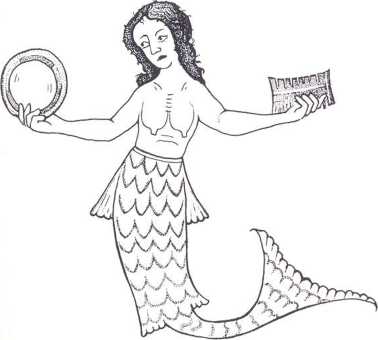394 (17)

367
Combs

244 Mermaid holding a mirror in one hand and a comb in the other c. 1325-35 after the Luttrell Psalter, BL Add. MS 42130 f.70b)
antler in medieval London, it is impossible to estimate how commonplace hom combs were. There is only one preserved from the period under survey, no. 1721, whereas there are at least five from the period 900 to 1150. Four of these latter combs were, however, identified on the basis of their bonę side-plates, which were a feature of hom combs in the lOth to early 12th centuries. Since the change to one-piece combs of hom coincided with the decline in output of antler composite combs and an uptum in the manufacture of combs of wood, the evidence points to a reorganisation of workshops specialis-ing in the production of combs during the 12th century.
The extent to which ivory combs were in everyday use can also only be conjectured. They are morę freąuently mentioned in documents than other kinds of comb on account of their high prestige, but such source materiał is unrepre-sentative of medieval society as a whole. By the 15th century they appear to have been commonplace among the upper classes, and the value of 6d placed upon one in the papers of the Pastons in the early 1470s (Davis 1971, 362) suggests that they were becoming cheaper as elephant tusks from India and Africa grew morę plentiful in western Europę. The pattem of long-distance trade in ivory, however, remains far from elear and it has recently been asserted that supplies of ivory into western Europę could have been great-ly reduced during the late-14th and 15th centuries causing other materials such as bonę, specially treated to imitate ivory, to capture the market for a time (Stratford 1987, 108-09).
Antler
(Antler identified by James Rackham)
1719 BIG82 acc. no. 2729 (context 4449) ceramic phase 7 figs 245 & 246
Double-sided composite comb with tooth-plates and connecting-plates cut from antler, and two end-plates and a centre-plate of bronze (AML). The connecting-plates are decorated with a pattem of openwork crosses and the comb is held together with rivets of copper alloy. No fine teeth are preserved and they appear to have been filed smooth after breakage.
1 77mm; 9 fine: 3 coarse teeth per lOmm.
1720 WAY83 128 (130) 9 (pre 1279) fig 245
End fragment of composite, single-sided comb with narrow connecting-plates held together with copper-alloy rivets, which pierce the tooth-plates. A hole was drilled through the end-plate. 10 teeth per lOmm.
Combs nos. 1719 and 1720 from 13th-century deposits (ceramic phases 7 and 9) are the only two madę from antler which fali into the period of this survey. The latter comes from a deposit with a terminus antę ąuem of 1279 and sherds of associated pottery suggest that the comb could have been discarded up to a century earlier. Both follow the tradition of Roman, Saxon and Viking-Age antler combs in being madę with separate tooth-plates and connecting-plates, as necessi-tated by the naturę of the raw materiał, but they possess important stylistic differences. In addi-tion, they are held together with rivets of copper alloy rather than of iron, which was usual for earlier composite combs (except for some combs in the 7th century and occasionally when copper-alloy rivets were used for repairs).
The single-sided antler comb has narrow connecting-plates, D-shaped in section, which extend the fuli length of the comb, and were apparently undecorated (no. 1720, fig 245). It was assembled with copper-alloy rivets, and while their exact seąuence cannot be determined
Wyszukiwarka
Podobne podstrony:
392 (16) 365 Cased Mirrors The mirrors in the first two categories above, which were mass-produced f
tX88072 (17) i *367
al creatures 17 Mermaid U LOVE TO SPLASH AROUND IN THE WAVES and swim with the fish. I visit the sho
fig901 MM Sun May 19 17:18:25 Sun May 19 - Sun May 19 Sun May 19 Netscape - [The Message B
17 UN DfiBAT ł LE3 MENTAUTES COLLErCTIVE3 607 In my next letter I will tell you morę of Constan
milo 01 17 This cxercise must be pcrformcd cxactlyas describcd. If you neglect any of the details.&n
New Forms Taschen 014 Pages 16/17 Rem Koolhaas Grand Palais Lille, France, 1990-94 Exterio
File0008 Hi! I m Martin l m 17 years old and Tm looking for e-mail friends of the same age from
244 Great Basin NaturalistMemoirs No. 11 __ 1955. Insert damage to the 195-4 crop of Douglas- fir an
14:00-17:00i; i we? C5II IMPLEMENTATION OF THE SAS EL STATEMENTS - COUNTRY AND REGIONAl ACTIONS.
17 Study lists17A The past tense of certain verbs (with past participle) Notę: These are the verbs u
L 178/2lENI Official Journal of the European Communities 17.7.2000 (6) In the light of Community obj
17 and budgets based on submissions from Research Program Coordinators and Statlon Hanagers. The pro
17 UN DfiBAT ł LE3 MENTAUTES COLLErCTIVE3 607 In my next letter I will tell you morę of Constan
więcej podobnych podstron